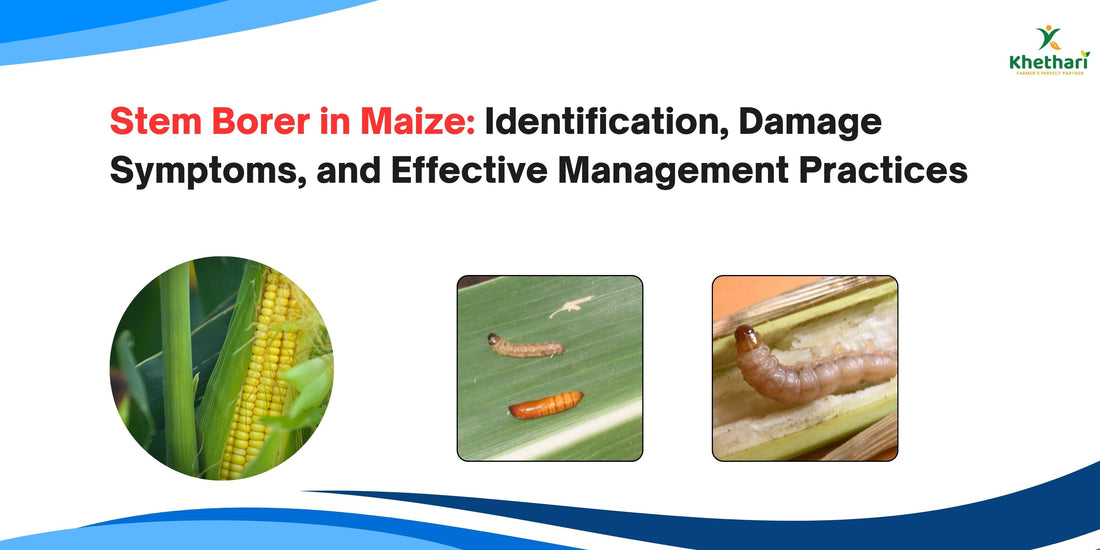
Stem Borer in Maize: Identification, Damage Symptoms, and Effective Management Practices
Introduction
Maize (Zea mays) is one of the most important cereal crops grown in India, valued for its use as food, fodder, and industrial raw material. It plays a vital role in ensuring food and nutritional security for millions of farmers. However, maize yield is often reduced due to various insect pests, among which the Stem Borer (Chilo partellus) is the most destructive.
Stem borers can cause up to 20–80% yield loss depending on infestation severity. Effective pest management practices are therefore essential to ensure higher productivity and profitability in maize farming.
Scientific Classification
- Common Name: Maize Stem Borer / Corn Borer
- Scientific Name: Chilo partellus
- Family: Crambidae (formerly Pyralidae)
- Order: Lepidoptera
Distribution and Favorable Conditions
The maize stem borer is widely distributed across India, Africa, and Southeast Asia.
In India, it is most common in:
- Telangana, Andhra Pradesh, Karnataka, Tamil Nadu, Maharashtra, Gujarat, and Uttar Pradesh.
Favorable Conditions:
- Warm and humid climate.
- Temperature between 25°C–30°C favors rapid multiplication.
- Continuous maize cultivation without crop rotation promotes buildup.
- Presence of leftover stubbles or alternate hosts such as sorghum and pearl millet.
Life Cycle of Stem Borer
The pest completes several generations per year, especially during the Kharif and Rabi maize seasons.
1. Egg Stage
- Female moths lay 100–200 eggs in clusters on the underside of maize leaves, often near the midrib.
- Eggs hatch within 4–6 days.
2. Larval Stage
- Newly hatched larvae feed on tender leaves, creating pinholes.
- Later instars bore into the stem and tunnel inside, disrupting nutrient flow.
- Larval duration: 18–25 days.
3. Pupal Stage
- Pupation occurs inside the stem or leaf sheath.
- Duration: 7–10 days.
4. Adult Stage
- Moths are straw-colored with brown markings on wings.
- Adults live for 3–4 days and continue the life cycle.
Field Identification Tip: Look for small pinholes on young leaves and “dead heart” symptoms in the early crop stage — these are clear early signs of infestation.
Symptoms of Damage
Early Stage:
- Pinholes in leaves forming a line pattern.
- Drying and withering of central shoot known as “dead heart.”
Later Stage:
- Boring and tunneling inside the stem.
- Broken stems and poor ear head formation.
- Reduced grain filling and overall plant vigor.
Economic Importance:
- Severe infestations can cause 25–80% yield loss, depending on crop stage and weather conditions.
Monitoring & Economic Threshold
Regular field monitoring helps in early detection and timely control.
Monitoring Methods:
- Use pheromone traps at 12/ha to capture adult moths and monitor pest activity.
- Check 10 plants randomly in each field section for early signs like pinholes or dead hearts.
Economic Threshold Level (ETL):
- Control measures should be taken when 10% of plants show dead heart symptoms or 5 moths/trap/night are recorded.
Integrated Pest Management (IPM)
A combined approach ensures effective, long-term control of maize stem borer while protecting beneficial insects and reducing pesticide use.
1. Cultural Control
- Practice crop rotation with non-host crops like pulses or oilseeds.
- Destroy stubbles and crop residues after harvest to eliminate larvae and pupae.
- Early sowing helps avoid peak pest activity.
- Grow resistant varieties such as DHM 117, COH(M) 5, and Prabhat.
2. Biological Control
- Release Trichogramma chilonis @ 50,000 adults/ha/week starting 20 days after sowing to parasitize eggs.
- Release Cotesia flavipes to attack larvae.
- Use Bt (Bacillus thuringiensis) formulations or Bt maize hybrids for sustainable control.
3. Chemical Control
When pest population exceeds ETL, apply any one of the following insecticides:
- Chlorantraniliprole 18.5% SC @ 0.3 ml/litre
- Spinosad 45% SC @ 0.3 ml/litre
- Emamectin benzoate 5% SG @ 0.4 g/litre
For control Stem Borer Use Larvex
Buy Now: https://www.khethari.com/products/larvex-insecticide?_pos=1&_sid=bd656b935&_ss=r

Safety Note:
Apply insecticides in the evening to avoid harming pollinators. Always follow recommended dosages and use protective gear.
4. Eco-Friendly Options
- Spray Neem-based formulations (Azadirachtin 0.3%) @ 5 ml/litre.
- Use bio-larvicides and botanical extracts for safe and residue-free pest control.
Preventive Measures
- Maintain clean fields and remove volunteer maize plants.
- Timely sowing to avoid peak borer activity.
- Apply balanced fertilizers, avoiding excess nitrogen.
- Regularly monitor for early symptoms and act quickly.
- Encourage natural enemies through reduced chemical usage.
Conclusion
The maize stem borer is a persistent threat to farmers, but with early detection and integrated pest management, its impact can be minimized effectively. Combining cultural, biological, and eco-friendly practices ensures both sustainability and profitability in maize cultivation.

